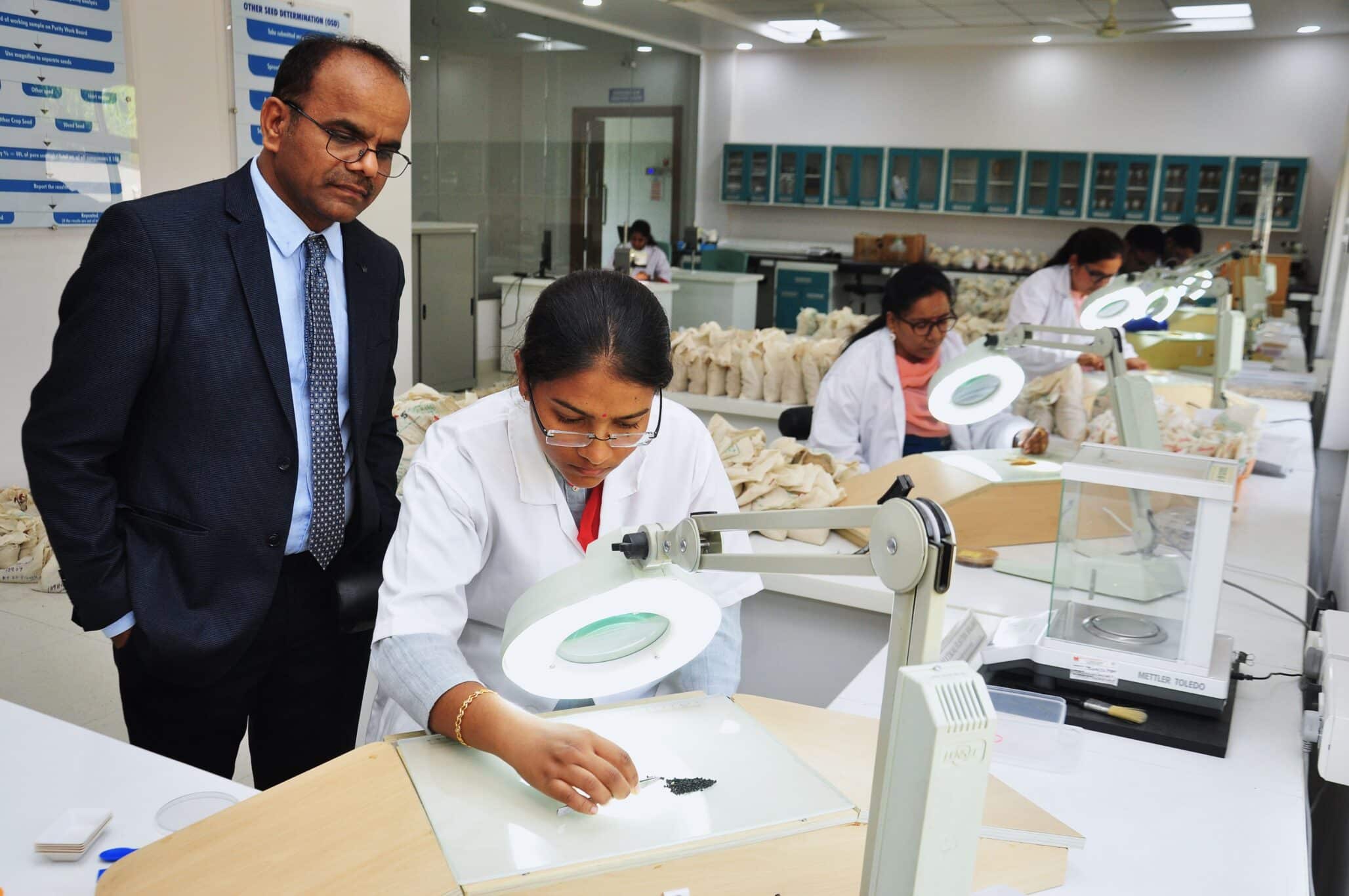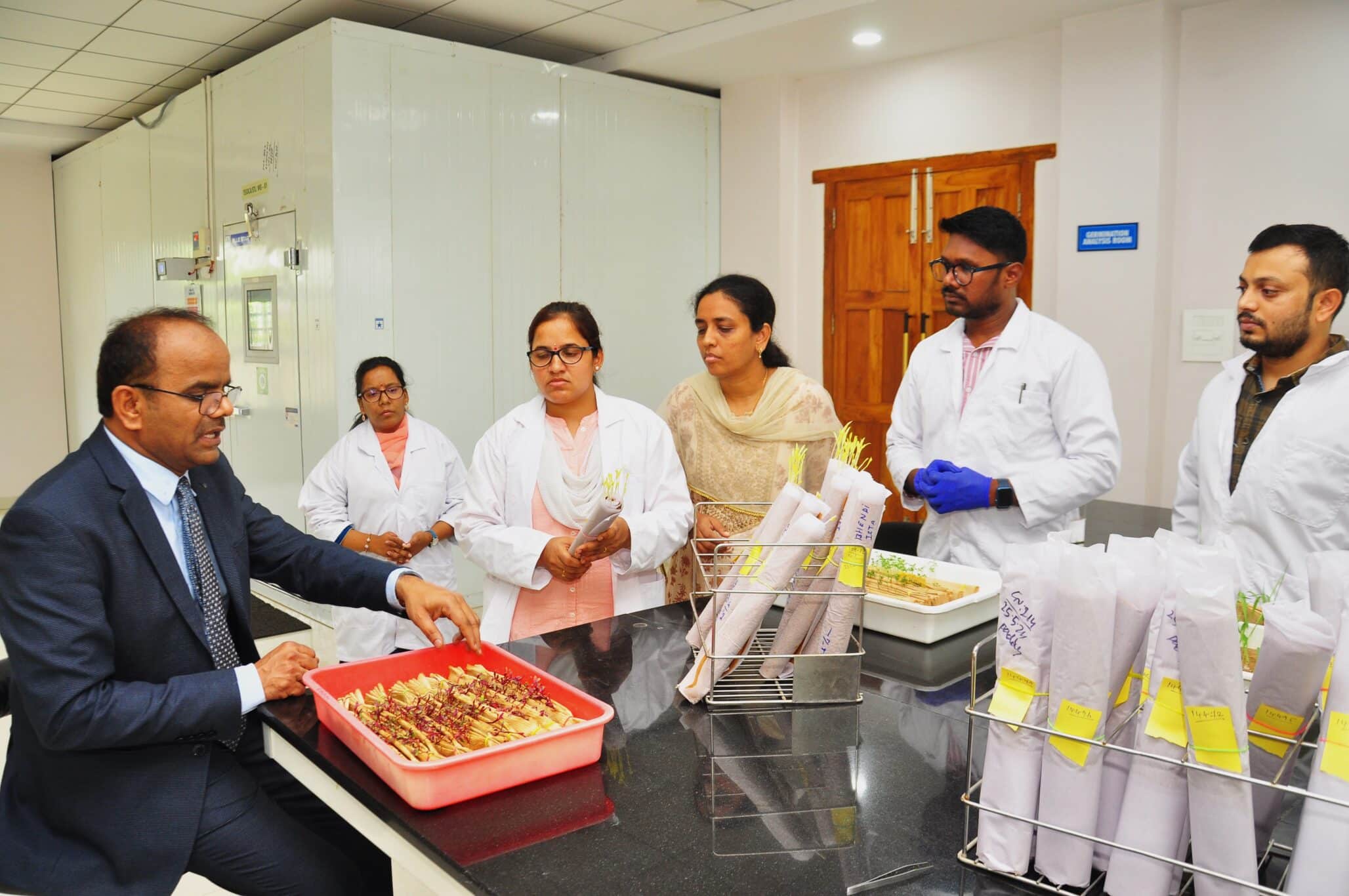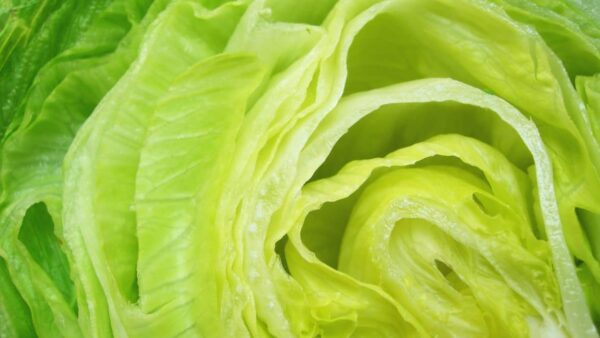For two decades, a central theme in the agricultural world discourse is the looming challenge of feeding the ever-growing world population. Historically, these challenges were resolved by increasing the area of cultivated land – a solution that is no longer viable on a significant scale. Much of the attention is centred on ways of increasing crop yield on the available land, and it is increasingly important that each seed planted by the farmer will successfully mature and yield. To this end, [tweetshareinline tweet=”safeguarding seed quality is among the first steps toward a satisfying yield” username=”EuropeanSeed”].
While the benefits of seed quality to the end user, i.e. the farmer and grower, are straightforward, how seed quality is defined, measured, and maintained is more complex. The objective of this article is to outline the importance of seed testing and its place in the framework of defining and maintaining seed quality.
Certified Seed
The importance of seed quality and consequently the need to control and monitor it is not new and was long recognized by governments and industry. This need prompted the development of national seed laws and international seed schemes for seed certification. Chief among these officialdoms internationally is the Organization for Economic Co-operation and Development (OECD) Seed Schemes that is ratified by 58 member countries. Other major regional seed certification entities include:
- Europe: the European Union seed regulations are captured by 12 different directives of the European Commission and are followed by the 27 European Union states.
- North America certification is voluntary and organized by the Association of Official Seed Certifying Agencies (AOSCA);
- Africa: Seed rules are harmonized by several regional organizations including the Southern African Development Community (SADC), the Economic Community of West African States (ECOWAS) and the Communaute Economique et Monetaire de l’Afrique Centrale (CEMAC);
- In Asia and Latin America seed rules are evolving and vary among countries.
The seed certification schemes and regulations consist of structured quality assurance processes applied to those varieties that are officially recognized as distinct, uniform, and stable. Some of the certification criteria addresses verification of varietal identity and varietal purity standards, previous cropping, isolation, and satisfactory conditions for the production and processing of basic and certified seed. These conditions are corroborated by field inspection and post-control tests. All these steps and conditions are designed to guaranty high quality seed. However, to assure quality the seed is required to further undergo laboratory seed testing, that is, seed quality assessment against set standards.
What is seed testing?
Seed testing describes procedures intended to characterize the physiological, genetic, and physical attributes of seed and enable informed decisions during research and development, seed production, and along supply chains and trade.
Seed sampling: Since most of the seed testing methods are destructive – that is, the seed used in testing is no longer viable, and because seed lots can be of a considerable size, testing is performed on samples. Sampling is of the outmost importance to the validity of the testing results and to the ability to interpret them; to justify the extrapolation of test results obtained by investigating a sample to the quality of its source the sampling scheme must be based on an appropriate statistical rationale and performed correctly. A sample should be of an adequate size to be representative of its source, and should be taken at random and according to a standardized protocol (for a complete description see ISTA international rules; Chapter 2).
Seed Quality Tests: The subsequent testing that the sampled seed undergoes is comprised of a series of analyses designed to assess different aspects of seed quality and include:
- Germination tests: these tests are designed to assess the ability of the seed to emerge, develop, and grow into a mature productive plant under standardized and agreed upon set of environmental conditions. There are several methods to conduct germination tests; for a description of the standard warm germination tests see ISTA or AOSA rules, or information with the Tamil Nadu Agricultural University (TNAU).
- Vigour tests: These tests are an extension of the germination tests; while germination is measured under close to optimal growth conditions, vigour tests were designed to determine the ability of the seed to emerge and grow into an adult viable plant under conditions that are more stringent and therefore may be a better representation of the conditions the seed will be facing in the field. Some of the vigour tests include a cold test, an accelerated aging test, and a Tetrazolium test. For a complete description, please see publications by ISTA or AOSA, or visit the Seed Laboratory section of Oregon State University.
- Seed Purity test: This is a physical inspection of the seed to determine if, and to what extent the seed is free from unintended seeds of other crops, weed seeds, and inert matter. For a complete description please see publications by ISTA or AOSA, or visit the Seed Laboratory section of Oregon State University.
- Moisture Content: Seed moisture content reflects its physiological state at harvest and its post-harvest processing. Since high moisture content is associated with potential poor storability and will have adverse effects on germination, this information is essential in determining seed quality and its future usability.
- Variety Identification tests: These tests aim at confirming that the sampled seeds are of the correct variety or genetic makeup. This confirmation is required to prevent cases of adulteration through seed mixes or outcrossing. As morphological inspection does not provide the required resolution to confidently differentiate different varieties of many crops, variety tests usually involve the use of biochemical methods such as isozyme electrophoresis or DNA markers although in some cases grow outs can be used as well.
- Trait purity and GMO (Adventitious Presence, AP) tests: These analyses are closely related to varietal identification; they too interrogate the genetic make-up of the tested seeds but they probe for the presence of specific genetic elements. Trait purity and GMO tests both aim at identifying and quantifying transgenic DNA elements, however, trait purity tests are conducted to assert that the seed is transgenic and carries the intended trait(s), while GMO tests are conducted to confirm the absence of transgenic seeds in conventional seed lots, or the adventitious presence of different events in a transgenic seed lot.
- Seed health tests: Disease and pathogens can have devastating and long-lasting effects on agricultural productivity. Therefore, it is important to be able to identify, quantify and prevent these threats as early as possible – this is the objective of seed health testing. Testing consists of a combination of a wide array of microbiological, molecular and plant pathology methodologies. The importance of seed health and the risks it may potentially present in international seed movement is exemplified by the fact that it became the subject of a dedicated, international set of phytosanitary rules: The International Standards for Phytosanitary Measures (ISPM) issued by the Food and Agriculture Organization of the United Nations (FAO) are defining standards for import and export of plant materials and are implemented independently by countries around the world.
Who is conducting seed testing?
Seed testing has started as a research endeavour in the 19th century, yet in recent years it evolved to be mostly an important facilitator of seed trade, an instrument of regulatory enforcement, and an important quality assurance tool for the seed industry. Respectively, the laboratories that conduct seed testing fall mostly in one of the following categories:
- Official laboratories: Governmental laboratories perform seed testing routinely as part of the enforcement of seed laws. Seed testing is conducted at the entry points of the seed into a given market, and includes imported seed, and locally grown seed that needs to be certified. In addition, these laboratories will often function as “testing for a fee”, similar to commercial seed laboratories.
- Seed industry laboratories: In the seed industry seed testing is performed as a quality assurance measure at various junctures along the life cycle of a product. Various tests, such as varietal tests and GMO testing may start as early as during the research and breeding efforts that lead to the development of a given variety, and will continue on a wider scale during production up until the seed is bagged. The specific points of testing will vary based on the general research, multiplication and production practices a company is using as well as other stewardship measures it employs. Company laboratories may also perform seed testing under the authorization of companies to perform some seed certification activities.
- Independent, commercial laboratories: The demand for seed testing, mostly in the private domain, far surpasses the volume of testing that government and industry laboratories can provide. This gap created the opportunity for commercial laboratory services that provide testing for a fee. Large commercial laboratory networks flourish in Europe and North America and their role is increasing in the rest of the world.
- Academic institutions: Many seed testing laboratories are housed within academic institutions. These laboratories may be part of research programs centred on seed technologies but very often they provide testing services to the adjacent agricultural community and industry either as part of an extension program or as a commercial testing provider.
Standards and standardization
For seed testing results to be meaningful and be understood and interpreted in a similar way globally, the testing methods used to assess seed quality should be agreed upon and followed in all testing laboratories. Test standardization needs to include agreement over the appropriate sampling method and sample size; all the minute steps, components, and conditions along the testing protocol; the units in which the results are expressed; and the format that the results are reported in. At the beginning of the 20th century seed scientists and analysts have set the foundation of two major organizations that are the pillars of seed testing standardization until present days: The Association of Official Seed Analysts (AOSA), and the International Seed Testing Association (ISTA)
AOSA: AOSA was formed in 1908 in an effort to perfect and publish uniform rules for seed testing. Members include official state, federal, and university seed laboratories across the United States and Canada. Another USA based organization, the Society of Commercial Seed Technologists (SCST) is mirroring the AOSA in the private sector, and includes seed technologists from commercial and company laboratories from across North America. The two organizations are working in concert through the activities of joint Standing Committees and subcommittees that are focusing on the creation and improvement of the AOSA seed rules, and ensuring that testing procedures are standardized between analysts and between laboratories. In addition to the seed testing rules, the main vehicle to seed testing standardization used by AOSA/SCST is the training and certification of seed analysts as Registered Seed Technologists (RST) and Registered Genetic Technologists (RSG) assuring that analysts are trained and operate according to their rules.
ISTA: ISTA was established in 1924 and according to the last published (2015) Annual Report enumerates 217 member laboratories and about 100 individual seed analysts from 80 different countries. The association was created as a forum for official government laboratories, and still today only government representatives have the right to vote. At the heart of the association are 18 technical committees, made up of expert analysts from around the world who are working together to develop and update seed testing methods. These methods are updated periodically and are voted into official rules once a year during an annual Ordinary General Meeting. The rules are published at the beginning of the consecutive year as the official ISTA rules. Complementing the rules are testing handbooks that include more detailed technical information and are updated when needed. The main instrument for testing standardization is the ISTA laboratory accreditation program. Accredited laboratories are audited once every three years for their adherence to the ISTA quality assurance standard and ISTA rules. In addition, the association is organizing several annual proficiency tests that allow laboratories to bench mark their testing capabilities. The participation in the proficiency tests is open to all laboratories, but it is mandatory for ISTA accredited labs which are required to consistently maintain a high score throughout the proficiency tests to retain their accreditation. ISTA accreditation provides laboratories with the right to provide their customers with ISTA certificates which are a standardized report of seed testing results and are yet another major contribution to international standardization. The ISTA certificates have created a common language that seed professionals across the world are using when it comes to parameters of seed quality. The International Seed Federation (ISF), the leading international seed trade organization, endorses the use of the certificates and they were incorporated as a requirement in a number of seed laws around the world.
The undisputed facts are that uniformity in seed testing reduces technical barriers, the use of standardized test reports/certificates increases transparency, and together they facilitate seed trade, and benefit the farmer.
Prospects and challenges
Our understanding of plant genetics, physiology, and pathology increased significantly in the last few decades. These advances were/are driven by technological innovations that have changed the ways we research plants and consequently apply the newly acquired knowledge; the rate of bringing new varieties in to the market is increasing in a unprecedent rate. These developments have a lot of promise but also present challenges that need to be considered:
- Forward looking research: [tweetshareinline tweet=”There is not enough research in the field of seed science and technology.” username=”EuropeanSeed”]. In the seed industry, which is a leading entity in agricultural research, the focus of the research and development departments is on biotechnology and genetic innovation. All major seed companies are engrossed in the competition to bring to market the next new super crop and very little effort is devoted to seed technologies. In academia, the appeal of seed science and technologies is very low, there are globally too few departments that are devoted to the topic and the research money is scarce. Much of the work is left to international seed organizations (ISTA, AOSA) where there is no culture of forward looking research, that is, the tendency is to work on a topic only after a problem was identified. The best example from recent years is GMO testing: whereas the first commercial GMO crop made it to the market in 1994, it was only in 2013 that ISTA voted in a new chapter focusing on GMO testing and the corresponding handbook is still under preparation. A similar challenge is looming presently with the advent of gene editing technologies. These technologies will challenge our present definition of a variety and the way we test and verify its identity; moreover, it will render our most common molecular GMO testing methods useless, but yet (to the best knowledge of the author), no forward-thinking effort is made to prepare for the challenges of testing gene edited varieties.
- Rate of change: Part of the problem in adapting seed rules to the present speedy change of the agricultural world is the lengthy process of voting in or changing a seed testing rules. While part of the slow pace is built in and required, as each new rule or change needs to be the result of a comprehensive study and should be validated, the process of approval can be expedited. There is no need to wait for the next opportunity when all voting parties congregate to pass a new rule or modification. In this day and age, with the digital and on-line tools that are available the dynamics of rulemaking should be adapted to stay relevant and to fit the pace of the surrounding scientific and business environment.
- At the intersection of the last two forth mentioned challenges lies the third, and possibly the hardest one: exploring new technologies for seed testing. Although advances are made in recent years in the use of digital imaging methods for seed purity testing, and varietal, GMO, and seed health testing are employing molecular methods, the physiological tests (germination, vigor) are using methods that have been around for decades. The fit of molecular methods as a new and better alternative are not guaranteed, however, the potential benefits are measurable – yet, not enough effort is made to explore the potential and materialize it.
Much of the efforts to increase agricultural productivity revolves around innovation in plant breeding and biotechnology. However, no matter how great an innovation is – it will be rendered useless if the resulting seed will not be able to make it to the market unchanged, unadulterated. As the investment in new breeding technologies and the cost to bring new varieties to market increases, so should the importance and the attention given to seed testing. If innovation is building the potential for yielding enough food to the world, seed testing is safeguarding the realization of this potential.














